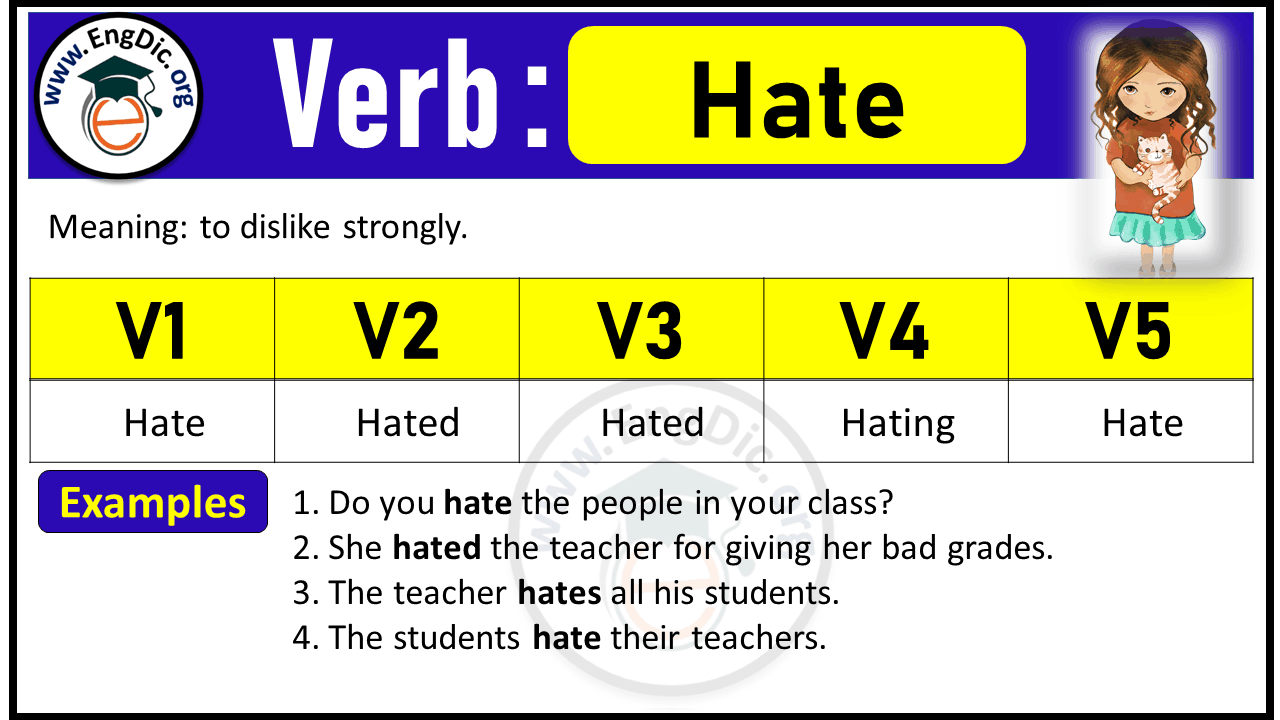Hate Past And Past Participle Form – V1 V2 V3 V4 V5 Form of Hate
Are you struggling to grasp the different forms of the verb “hate”? You’re not alone.
Understanding verb forms can be tricky, yet mastering them is crucial for effective communication. We’ll unravel the mystery behind the past and past participle forms of “hate”—V1, V2, V3, V4, and V5. Whether you’re a student, a writer, or just someone looking to polish your language skills, we’ve got you covered.
We’ll make this complex topic simple and easy to digest, so you can confidently use the correct form every time. Stick around, and discover how mastering these forms can enhance your English fluency and boost your confidence in any conversation.
Hate (Meaning / Definition)
The verb hate means to feel intense or passionate dislike for someone or something; to detest.
Example:
“I truly hate doing laundry in the summer heat.”
Forms of the Verb “Hate”
The verb hate is a regular verb.
Its past tense and past participle forms are created by simply adding -d (since the base form already ends in ‘e’).
| Form | Name | Form | Example Sentence |
|---|---|---|---|
| V1 | Base Form / Present Simple | hate | Many people hate long commutes. |
| V2 | Simple Past | hated | He hated school when he was young. |
| V3 | Past Participle | hated | She has always hated being the center of attention. |
| V4 | Present Participle / Gerund | hating | I’m hating this cloudy weather right now. |
| V5 | Third Person Singular Present | hates | My brother hates spiders with a passion. |
Understanding the word hate in different forms can be easy. The base form is V1 – hate. The past form is V2 – hated. The past participle is also V3 – hated. The present participle or gerund form is V4 – hating. Finally, the third-person singular form is V5 – hates.
People use these forms in different tenses. For example, “I hate broccoli” uses the base form. “She hated the movie” uses the past form. “They have hated this rule for years” uses the past participle. “He is hating this game” uses the gerund form. “She hates getting up early” uses the third-person form.

Credit: engdic.org
Past Tense Usage
Past Participle ApplicationHate Past And Past Participle Form V1 V2 V3 V4 V5 Form of Hate
The past participle form of hate is hated. We use it to show actions that are completed. You can say, “He has hated the noise since last year.” This means he disliked the noise before and still does.
In stories, past participles help describe past events. “She had hated broccoli since childhood.” This tells us her feelings about broccoli began long ago. When talking about experience, past participles express past actions. For example, “They have hated rainy days.” This means they disliked rainy days before.
Past participles are common in perfect tenses. They help show completed actions. Remember, past participles are key in expressing past events. They make sentences clear and easy to understand.
Examples of the Verb “Hate” in All Forms
Here are example sentences illustrating the usage of each form of the verb hate:
| Form | Example Sentence | Explanation |
|---|---|---|
| V1 (Hate) | I hate waking up before sunrise. | Base form used with the subject ‘I’ in the Simple Present tense. |
| V2 (Hated) | We all hated the ending of that movie. | Simple Past tense, describing a completed action in the past. |
| V3 (Hated) | I have always hated being told what to do. | Past Participle used with the auxiliary verb ‘have’ to form the Present Perfect tense. |
| V4 (Hating) | She is currently hating the new software update. | Present Participle used with the auxiliary verb ‘is’ to form the Present Continuous tense. |
| V5 (Hates) | My sister hates spicy food. | Simple Present tense (third person singular) used with the subject ‘sister’ (she). |
Conclusion
Understanding verb forms makes English easier. Hate’s forms are simple: hate, hated, hated. Practice these forms daily. Use them in sentences. Speaking improves learning. Learning verbs helps in writing and speaking. It’s important for communication. Regular practice is key. English gets easier with practice.
Keep learning. Keep improving. Verbs are essential in English. They form the backbone of sentences. Mastering them boosts confidence. Simple tips make a big difference. Enjoy the journey of learning.






